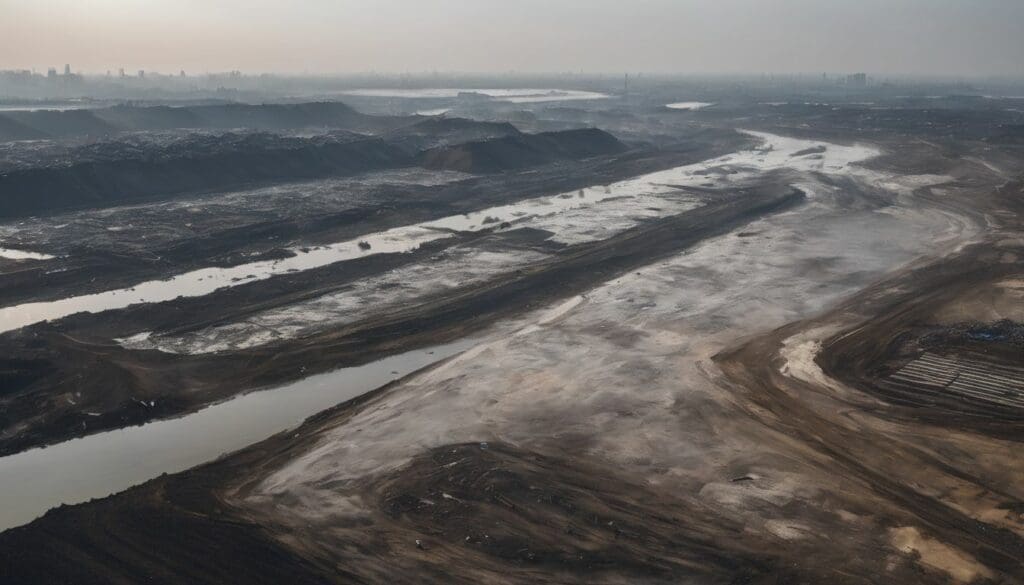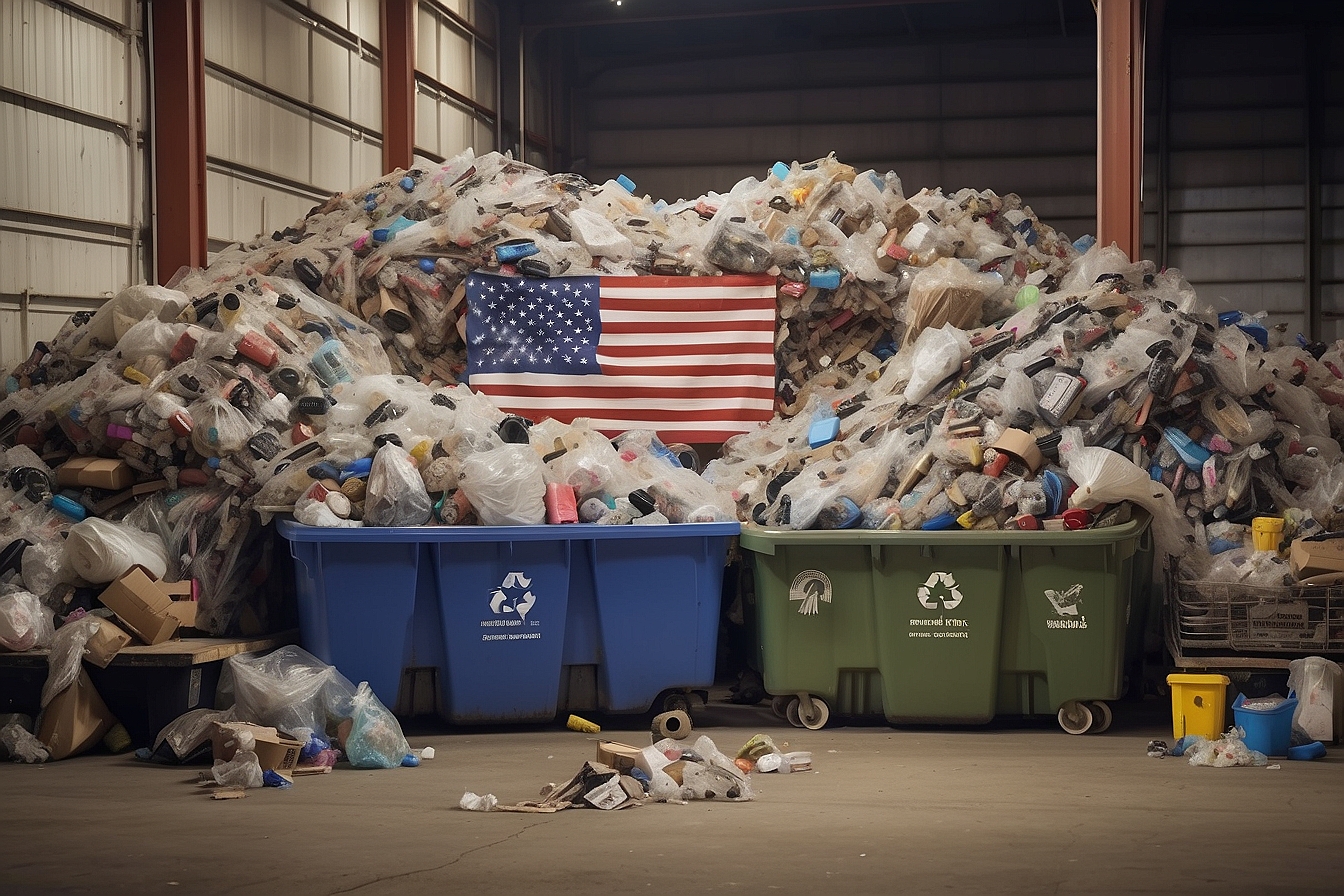Landfills are more than a blot on the landscape; they’re an ever-growing environmental and communal headache that many of us grapple with each day. We understand the struggle all too well, we’ve sifted through piles of data to grasp the true extent of their impact – did you know that landfills contribute to nearly 15% of methane emissions right here in the UK? Our insights will illuminate not only how these waste mountains affect our dear planet but also how they touch upon our wellbeing and living spaces.
Stay tuned as we unearth more about this pressing matter that’s very much on our doorstep.
Key Takeaways
- Landfills release methane, a greenhouse gas contributing to climate change and global warming.
- Living near landfills can pose health risks like respiratory problems and skin irritation due to exposure to hazardous materials.
- Leachate from landfills contaminates water and soil, threatening ecosystems and local wildlife habitats.
- Property values decrease in areas close to landfills, affecting residents’ investment returns and increasing their cost of living.
- Alternative waste management options such as recycling, composting, waste-to-energy plants, and product stewardship initiatives offer sustainable solutions.
Impacts of Landfills on the Environment
Landfills have a significant impact on the environment, including contributing to climate change through the release of greenhouse gases, posing health risks to nearby communities, contaminating water and soil, disrupting local wildlife habitats, reducing property values, and increasing the likelihood of accidents and fires.
Climate change
We see our landfills contributing to climate change by releasing methane, a potent greenhouse gas. Methane traps much more heat in the atmosphere than carbon dioxide, accelerating global warming.
Our rubbish heaps are essentially giant incubators for this harmful gas. Decomposing organic waste like food scraps and garden cuttings produces methane, especially when buried without oxygen.
Taking action is crucial; we can’t ignore how solid waste management impacts our planet’s health. By improving how we handle waste, reducing what goes into landfills, and capturing the gases they emit, we play a vital role in tackling anthropogenic greenhouse gas emissions.
It’s about preserving ecosystems and ensuring sustainable development for future generations while combating environmental pollution head-on.
Health risks
Health risks associated with landfills pose significant concerns for public health. The release of hazardous materials from decomposing waste can contaminate air and water, leading to serious health effects such as respiratory problems, skin irritation, and other related illnesses.
In addition, the exposure to pollutants from landfill sites may also impact local communities’ mental well-being, contributing to stress and anxiety due to perceived risks.
Furthermore, living near a landfill site exposes individuals to an increased risk of developing various health conditions due to prolonged exposure to poor air and water quality. It is vital for communities to advocate for sustainable waste management solutions that prioritise public health and address the potential long-term impacts on nearby residents’ well-being.
Water and soil contamination
As we consider the impact of landfills on the environment and communities, it’s essential to address the issue of water and soil contamination. Landfills often lead to the pollution of both ground and surface waters due to leachate, a highly toxic substance that results from decomposing waste.
As rainwater seeps through layers of garbage, it accumulates harmful chemicals and toxins before entering the soil and groundwater, adversely affecting ecosystems and posing public health concerns.
Furthermore, the degradation caused by landfill activities contributes to ecosystem distress; this includes resource depletion, ecosystem degradation, biodiversity loss, and habitat destruction.
Disruption of local wildlife
Water and soil contamination caused by landfills can have detrimental effects on local wildlife. Habitat loss and degradation, as well as the pollution of ground and surface waters, directly impact the ecosystem around landfill sites.
The contamination of soil and groundwater also poses significant risks to the flora and fauna in these areas, with potential long-term consequences for biodiversity.
Habitat loss
Contamination of soil and groundwaterHealth effects of landfill sites
Reduced property value
Disruption of local wildlife can have a direct impact on property values in the surrounding area. When natural habitats are disrupted or destroyed by landfill development, it can lead to decreased property values.
Potential buyers may be deterred from purchasing homes near landfills due to concerns about environmental hazards and health risks associated with proximity to waste disposal sites.
Furthermore, the stigma attached to living near a landfill can also contribute to reduced property values. The negative perception of potential health risks and environmental degradation associated with landfills often results in decreased demand for properties in the vicinity, ultimately leading to lower market prices.
Accidents and fires
Reduced property value can be just the start of the problems associated with landfills. Accidents and fires are additional risks that can arise due to the accumulation of flammable and hazardous materials in landfill sites, impacting both the environment and nearby communities.
These incidents pose a significant danger to wildlife, water sources, soil quality, and air pollution levels. In turn, this endangers local residents’ health and safety as well as further contributing to environmental deterioration.
Thus, it is crucial for environmentally conscious individuals to consider these risks when advocating for sustainable waste management solutions.
Effects of Landfill on Communities
The presence of landfill sites can impact the perception of environmental problems within communities and may also have long-term effects on human health. Additionally, living near a landfill can alter daily life and increase the cost of living for residents in these areas.
Perception of environmental problems
Communities living near landfill sites often perceive environmental problems as a significant concern. The visibility of waste and the associated odors can create distress and unease among residents, impacting their sense of well-being and quality of life.
In addition, the knowledge that harmful chemicals and pollutants are being deposited into the environment can instill worry about long-term consequences for both current and future generations.
Understanding the perception of environmental issues in communities near landfills is crucial for developing effective strategies to mitigate these concerns. By acknowledging and addressing these perceptions, it becomes possible to foster more constructive dialogues between stakeholders, leading to improved environmental management practices and community engagement.
Impact on human health
Landfill sites pose significant health risks to nearby communities. The accumulation of waste leads to the release of harmful chemicals and gases such as methane, which can cause respiratory problems and exacerbate existing conditions like asthma.
In addition, exposure to toxins from decomposing waste can result in skin irritation, headaches, nausea, and other acute health issues for individuals living in close proximity to landfills.
Moreover, the presence of vermin attracted by landfill sites may increase the risk of vector-borne diseases such as West Nile virus or Lyme disease. Furthermore, the persistent odors emanating from these areas can lead to psychological stress and potential long-term mental health impacts on residents.
Alteration of daily life
Transitioning from the impact of landfill sites on human health to the alteration of daily life, it’s important to note that living near a landfill can significantly disrupt everyday routines.
The constant noise, unpleasant odors, and increased traffic associated with waste disposal activities contribute to a decrease in overall quality of life for those residing nearby.
Moreover, the psychological strain of being constantly reminded of environmental issues can lead to heightened stress levels and a sense of helplessness. As environmentally conscious individuals who value their well-being and surroundings, it’s crucial to consider these implications when addressing the presence and expansion of landfill sites.
Cost of living near a landfill
Living near a landfill can significantly impact the cost of living for nearby residents. Property values tend to decrease as potential buyers are deterred by the proximity to waste disposal sites, leading to a reduced return on investment for homeowners.
Additionally, higher insurance premiums may be required due to increased health and safety risks associated with living near landfills, further increasing the financial burden on residents in these areas.
Furthermore, expenses related to healthcare can rise as exposure to air and water pollution from landfills can lead to an increase in respiratory issues and other health problems within affected communities.
Alternatives to landfill sites
Landfill sites have detrimental impacts on the environment and communities. It is crucial to consider alternatives to landfill sites that are more sustainable and environmentally friendly. Here are some effective alternatives to traditional landfill sites:
- Waste Reduction and Recycling Programmes: Implementing comprehensive waste reduction and recycling programmes can significantly reduce the amount of waste sent to landfills, conserving natural resources and reducing environmental pollution.
- Composting Facilities: Establishing community composting facilities can divert organic waste from landfills, producing nutrient-rich compost for gardening and agriculture, while also mitigating greenhouse gas emissions.
- Waste-to-Energy Plants: Utilising advanced technology in waste-to-energy plants can convert non-recyclable waste into energy, providing a renewable energy source while minimising the volume of solid waste sent to landfills.
- Sustainable Material Recovery Facilities: Developing sustainable material recovery facilities can effectively sort and process recyclable materials, diverting them from landfills and promoting a circular economy.
- Landfill Mining: Engaging in landfill mining operations involves extracting valuable resources from existing landfills, reducing the need for additional landfill space while reclaiming materials for reuse or recycling.
- Hazardous Waste Treatment Centres: Establishing specialised hazardous waste treatment centres enables safe disposal or remediation of toxic substances, protecting public health and preventing environmental contamination.
- Product Stewardship Initiatives: Implementing product stewardship programmes encourages manufacturers to take responsibility for their products’ end-of-life management, promoting eco-friendly design, reuse, and recycling practices.
- Construction of Anaerobic Digestion Plants: Investing in anaerobic digestion plants can process organic waste to produce biogas for energy generation while capturing valuable nutrients for agricultural use, contributing to a circular economy approach.
Conclusion
In conclusion, the impact of landfills on the environment and communities is considerable. Communities near landfills experience health risks, altered daily lives, and increased living costs.
On the environmental front, climate change, soil contamination, and disruption of wildlife all contribute to a significant negative impact. It’s crucial for us to explore alternative solutions to lessen these effects.
FAQs
1. What is the impact of landfills on the environment?
Landfills can harm the environment by contaminating local soil and water sources, which affects nearby wildlife and ecosystems.
2. How do landfill sites affect community health?
Communities close to landfill sites may experience health effects due to air pollution from harmful gases and potential groundwater contamination.
3. Can living near a landfill cause health problems for people?
Yes, living near a landfill can lead to certain health issues caused by pollutants released into air and water, impacting residents’ overall wellbeing.
4. What steps are being taken to reduce the impact of landfills on communities?
Efforts are ongoing to manage waste more responsibly, improve landfill technology, and monitor their effects on both community health and environmental safety.





